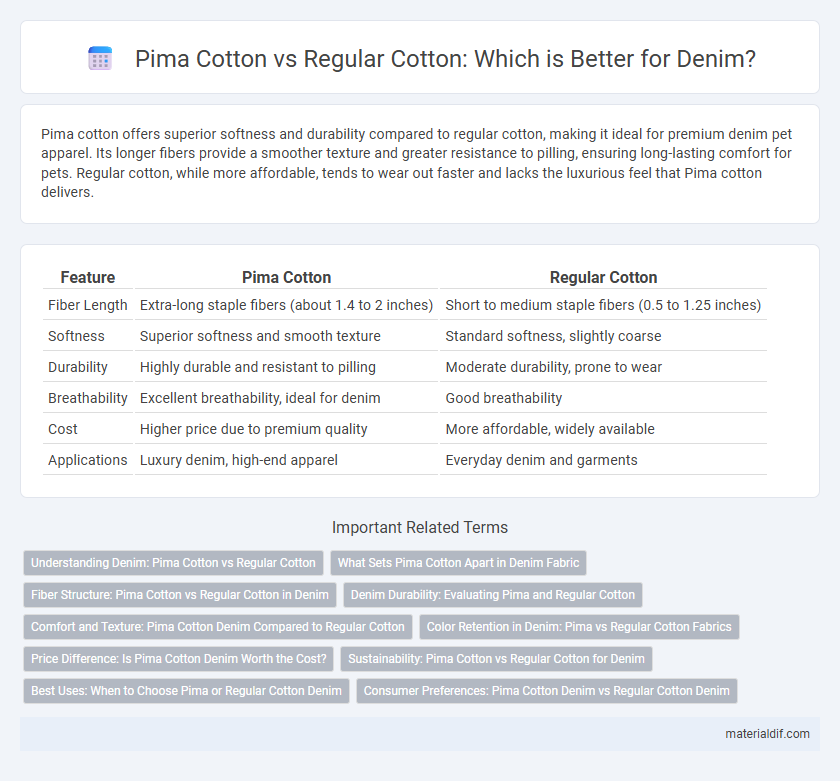Pima cotton offers superior softness and durability compared to regular cotton, making it ideal for premium denim pet apparel. Its longer fibers provide a smoother texture and greater resistance to pilling, ensuring long-lasting comfort for pets. Regular cotton, while more affordable, tends to wear out faster and lacks the luxurious feel that Pima cotton delivers.
Table of Comparison
| Feature | Pima Cotton | Regular Cotton |
|---|---|---|
| Fiber Length | Extra-long staple fibers (about 1.4 to 2 inches) | Short to medium staple fibers (0.5 to 1.25 inches) |
| Softness | Superior softness and smooth texture | Standard softness, slightly coarse |
| Durability | Highly durable and resistant to pilling | Moderate durability, prone to wear |
| Breathability | Excellent breathability, ideal for denim | Good breathability |
| Cost | Higher price due to premium quality | More affordable, widely available |
| Applications | Luxury denim, high-end apparel | Everyday denim and garments |
Understanding Denim: Pima Cotton vs Regular Cotton
Pima cotton, known for its extra-long staple fibers, produces denim fabric with superior softness, strength, and durability compared to regular cotton. This enhanced fiber quality results in denim that resists pilling and maintains color vibrancy after multiple washes. Regular cotton denim, while more common and cost-effective, typically lacks the smooth texture and long-lasting resilience found in Pima cotton denim.
What Sets Pima Cotton Apart in Denim Fabric
Pima cotton is distinguished by its extra-long staple fibers, which create denim fabric that is stronger, softer, and more durable than denim made from regular cotton. The superior fiber length contributes to a smoother texture and less pilling, enhancing the overall quality and longevity of denim garments. This results in denim that retains vibrant color and comfort even after multiple washes, making Pima cotton a premium choice for high-end denim products.
Fiber Structure: Pima Cotton vs Regular Cotton in Denim
Pima cotton features longer and finer fibers compared to regular cotton, resulting in a smoother, stronger, and more durable denim fabric. The extra-long staple length of Pima cotton contributes to less pilling and increased resistance to wear, enhancing denim longevity and comfort. Regular cotton's shorter fibers often produce a coarser texture and lower tensile strength, leading to quicker degradation in denim garments.
Denim Durability: Evaluating Pima and Regular Cotton
Pima cotton is renowned for its longer staple fibers, which contribute to superior denim durability compared to regular cotton, resulting in stronger, more resilient fabric that resists fraying and wear. The finer, smoother fibers of Pima cotton enhance the denim's softness while maintaining high tensile strength, making it ideal for long-lasting jeans. Regular cotton denim, with shorter staple fibers, tends to show signs of wear more quickly under stress, making Pima cotton a preferred choice for premium, durable denim.
Comfort and Texture: Pima Cotton Denim Compared to Regular Cotton
Pima cotton denim offers superior softness and a smoother texture due to its extra-long staple fibers, resulting in enhanced comfort compared to regular cotton denim. The finer fibers of Pima cotton create a fabric that feels silkier against the skin and exhibits greater durability and resistance to pilling. Regular cotton denim tends to be coarser and less breathable, making Pima cotton denim a preferred choice for premium comfort and luxury in denim apparel.
Color Retention in Denim: Pima vs Regular Cotton Fabrics
Pima cotton denim exhibits superior color retention compared to regular cotton fabrics due to its longer, stronger fibers that absorb dye more effectively. The enhanced fiber quality in Pima cotton minimizes fading and maintains vibrancy through multiple washes, ensuring the denim's appearance remains fresh over time. Regular cotton denim, made from shorter fibers, tends to lose color faster, leading to noticeable fading and diminished fabric integrity after repeated wear.
Price Difference: Is Pima Cotton Denim Worth the Cost?
Pima cotton denim commands a higher price than regular cotton denim due to its superior softness, durability, and longer staple fibers that produce a smoother fabric. The investment in Pima cotton often results in denim with enhanced comfort and longevity, justifying the increased cost for consumers seeking premium quality. While regular cotton offers affordability, Pima cotton denim delivers a luxury experience that many find worth the financial premium.
Sustainability: Pima Cotton vs Regular Cotton for Denim
Pima cotton is more sustainable than regular cotton for denim due to its longer fibers, which produce stronger, longer-lasting fabric that reduces the need for frequent replacement and waste. It requires less water and fewer pesticides compared to conventional cotton, lowering the environmental impact of denim production. Choosing Pima cotton supports sustainable practices by promoting durability and conserving natural resources in denim manufacturing.
Best Uses: When to Choose Pima or Regular Cotton Denim
Pima cotton denim is ideal for premium, durable garments requiring a soft, luxurious feel and enhanced color retention, making it perfect for high-end jeans and apparel. Regular cotton denim is better suited for everyday wear and budget-friendly options, offering reliable durability with a more rugged texture. Choosing Pima cotton is best for long-lasting, comfortable denim, while regular cotton provides cost-effective, classic denim material.
Consumer Preferences: Pima Cotton Denim vs Regular Cotton Denim
Pima cotton denim is preferred by consumers seeking superior softness, strength, and durability compared to regular cotton denim, which tends to be rougher and less resilient. The long staple fibers of Pima cotton result in a smoother texture and enhanced color retention, making it a favorite for premium denim products. Regular cotton denim appeals to budget-conscious buyers but may lack the luxurious feel and longevity found in Pima cotton alternatives.
Pima Cotton vs Regular Cotton Infographic

 materialdif.com
materialdif.com